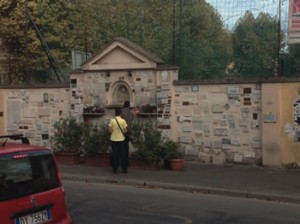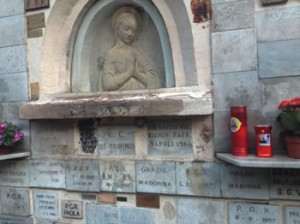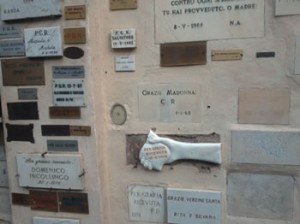An Attitude of Gratitude
I have been travelling of late. I am lucky enough to be in a job where I am expected to go on sabbatical and write learned articles. That is what I am engaged upon at present. Travel is said to broaden the mind and I am experiencing something of that. Other cultures do things differently, including how they live their Catholicism. Yes, the Church is universal but it expresses that in the local. You feel you belong in a Catholic Church anywhere in the world, yet you notice lots of subtle differences.
The photos accompanying this article are from Rome, Italy. Italy has an extremely Catholic culture and while churchgoing is in decline the symbols of Catholicism persist everywhere.
Each block of apartments has a sacred image somewhere on the exterior. The saint depicted is being asked to protect that apartment block and its inhabitants. There is great devotion to the Mother of God and images of Mary are in the majority.
The shrine shown in the photos is on a wall alongside a busy main street. It is a very public place opposite a bus and tram stop. The relief of Mary and Jesus was put on the wall about 1950 and, while pretty, is in no way exceptional.
Since being erected it has become a focus of devotion, one of many in the city. People leave flowers and candles before the image. They pause before it to pray. They also sometimes leave expressions of thanks.
I was struck here and elsewhere by the “ex votos” – the expressions of gratitude for prayers having been answered. There seems to be no system in how they are arranged on the wall. People have just plastered them on wherever there was a space. There are marks where earlier ones have fallen off. The messages on them are simple and repetitive. Often they abbreviate it to P.G.R. – “for graces received”. Others include: “You have provided, O Mother”, “Thanks holy Virgin”, “O Jesus, thank you.” Sometimes a name, or initials, will be included and often a date.
I loved the “public-ness” of it all. In New Zealand we tend to be quite private and discrete about our faith. Here were people happily lighting a candle to Mary in front of passing crowds. Here were families who wanted to publicly acknowledge that the prayers they had made before this simple shrine had been answered.
My impression was that Italians are good at gratitude. The word “Gratia” comes up often, invariably with the response “Prego”. The phrase books translate that as “Thank you” and “You’re welcome” but the literal sense of the exchange is “Grace” “I pray”. For each small service done; the handing over of the money in a shop, saying farewell, holding a door, you are literally blessed with grace, and you pray that it may be so.
Italian Catholicism has taught me about confident faith, public symbols, the love of Mary and about the attitude of gratitude.



 Entries(RSS)
Entries(RSS)